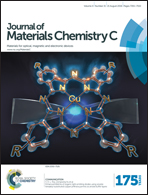Structural analysis and thermoelectric properties of mechanically alloyed colusites†
Abstract
We describe here a new, easy and scalable route for synthesising colusites by using mechanical-alloying and reactive spark plasma sintering, together with the thermoelectric behaviour of zinc-substituted derivatives, Cu26−xZnxV2Sn6S32 (0 ≤ x ≤ 2). X-ray diffraction analysis coupled with transmission electron microscopy evidences the high crystallinity of the as-synthesized samples. In the pristine compound, an intrinsic exsolution phenomenon leads to the formation of two distinguishable colusite phases. Additional neutron powder diffraction results support the substitution of Zn in the tetrahedral Cu sites and 119Sn Mössbauer spectroscopy analyses prove the presence of only Sn4+ in colusite irrespective of the Zn content (x ≤ 2). The mechanical properties denote a wide homogeneity of the samples despite a significant impact of the exsolution on the microstructure. The Zn for Cu substitution provides electron doping, decreasing the holes concentration. High temperature thermoelectric properties in the p-type series Cu26−xZnxV2Sn6S32 are reported. The highest power factor of 0.92 mW m−1 K−2 at 700 K is found for x = 1, with a corresponding ZT value of 0.4.


 Please wait while we load your content...
Please wait while we load your content...